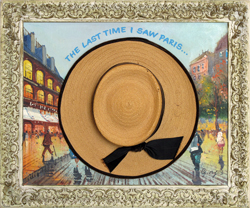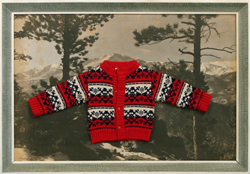Alexis Smith
Second Nature
Images | Biography
April 20 - May 25, 2013
Reception: April 20, 2013 4-6PM
Gallery Talk: May 18, 2013, 10am
Alexis Smith’s brand of Pop infused Conceptualism has been compared to the highly irreverent, yet equally serious work of other L.A. icons, Ed Ruscha, John Baldessari and Mike Kelley. Her exhibition at Craig Krull Gallery, entitled Second Nature, employs found paint-by-number and black velvet landscapes overlaid with remnants of popular culture and pithy literary references that combine to offer multi-dimensional readings into our relationship with Nature and our mental construct of landscapes. Describing Smith’s work in the catalogue of her mid-career survey at the Whitney and MOCA in 1991-92, Richard Armstrong wrote, “her work exists in the gap between text and image, past and present, word and thing, ordinary and extraordinary. She unites thought and physical perception, relying on the eye and memory to make a synthesis. Smith is most successful when otherwise unrelated thoughts and objects are seamlessly melded together, when fragments from our mental and physical lives are ’reunited’.” In Rule of Thumb, a work from the exhibition at Craig Krull Gallery, Smith places a wooden ruler imprinted with the phrase, “A rule to prevent forest fires…Smokey’s friends don’t play with matches” on top of a romantic landscape print with stags, forest, rushing stream and snow-capped mountains. The work addresses our contemporary role as both steward and destroyer of Nature, as well as our desire to classify and measure the natural world from abstract, analytical and scientific points of view. In another work, The Last Time I Saw Paris, a touristy Montmartre painting has a charming hat floating on top of it that reminds one of Madeline in the Ludgwig Bemelmans stories, or Leslie Caron in Lili. Above the hat are painted the words of the artwork’s title. In this piece, Smith plays with our romantic and nostalgic notions associated with a sense of place, as well as the attendant stereotypes and cultural clichés. In all of her work however, Alexis Smith never tells you what to think; her art evokes endless free-associations that emphasize the key role the observer plays in completing the picture.


